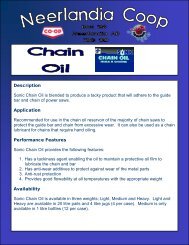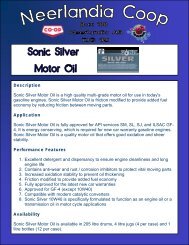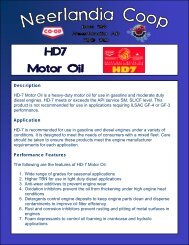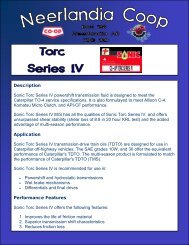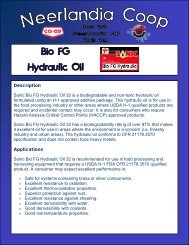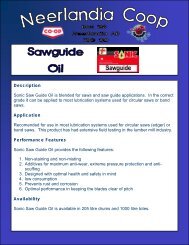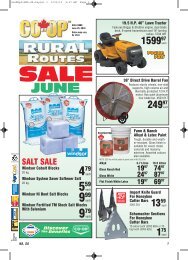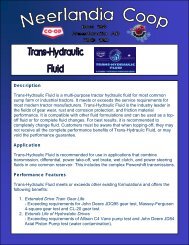MSDS Unlimited(tm) - Neerlandia Co-op
MSDS Unlimited(tm) - Neerlandia Co-op
MSDS Unlimited(tm) - Neerlandia Co-op
- No tags were found...
Create successful ePaper yourself
Turn your PDF publications into a flip-book with our unique Google optimized e-Paper software.
MATERIAL SAFETY DATA SHEET <strong>MSDS</strong> File Number: 62SECTION I - MATERIAL IDENTIFICATION AND USEFLAMMABILITY 1Material Name / Product IdentifierTRANS-HYDRAULIC FLUIDREACTIVITY 0Manufacturer's Name<strong>Co</strong>nsumers' <strong>Co</strong>-<strong>op</strong>erative RefineriesLimitedP.O. Box 260; 550E 9th Avenue NorthRegina, SK S4P 3A1 CANADA(306) 721-5353Emergency Telephone NumberSupplier's NameFederated <strong>Co</strong>-<strong>op</strong>eratives LimitedP.O.Box 1050; 401 - 22nd Street EastSaskatoon, SK S7K 3M9 Canada(306) 244-3447Emergency Telephone Number(613) 966-6666 (Canutec)Chemical Name Chemical Family Chemical FormulaN.D.N.D.Mixture.Molecular Weight Trade Name and Synonyms Material UseN.D.N.D.SECTION II - HAZARDOUS INGREDIENTS OF MATERIALSHazardous IngredientsApproximate<strong>Co</strong>ncentration %C.A.S.Numbers Exposure Limits LD50 / LC 50 (Species and Route)Base Oil 60.0 - 100.0 % (ACGIH) TLV-TWA 5 mg/m3 (oilmist)HEALTHMfg Reference NumberTransmission and hydraulic oil.(Acute)(Chronic)(LD50) Oral (rat) > 5,000 mg/kg0NAdditive Package (*) 9.0 - 14.0 % (ACGIH) TLV-TWA 5 mg/m3 (oilmist)Zinc Alkyl Dithi<strong>op</strong>hosphate(**) 1.2 - 1.7 % 68649-42-3(*) Denotes: Additive package containing rust/oxidization inhibitor, anti-foam agent, anti-wear compound and viscosity modifier. (**) Denotes: <strong>Co</strong>mponent of the additivepackage.SECTION III - PHYSICAL DATA FOR MATERIALPhysical StateLiquidVapour PressureN.D.Solubility in Water (20 C)SlightOdour and AppearanceVapor Density (Air = 1)% VolatilesSECTION IV - FIRE AND EXPLOSION HAZARD OF MATERIAL<strong>Co</strong>nditions of FlammabilityMeans of ExtinctionSpecial ProceduresFlash Point and Method> 148.0 C (Open Cup) N/A N/A 413.0 CExplosion Data - Sensitivity to Mechanical ImpactSECTION V - REACTIVITY DATAChemical StabilityIf no, underwhichconditions?Brown oily liquid; mild odourN.D.Upper Explosion LimitEvaporation RateN.D.pHLower Explosion LimitExplosion Data - Sensitivity to Static DischargeOdour Threshold (ppm)Boiling PointN.D. N.D. N.D.May form combustible mixtures with air at temperatures at or above the flashpoint.Foam, water spray, dry chemical, carbon dioxide.N.D.N.D.Specific Gravity0.8853 @ 15.6 CFreezing / Pour Point-40 C<strong>Co</strong>efficient of water / oil distribution<strong>Co</strong>ol fire exposed containers with water spray. Due to danger of sl<strong>op</strong> over, avoid getting water into containers. Move containers away from fire area if atno risk. Vapours may travel to distant ignition sources and flashback. Fire fighters should wear self contained breathing apparatus.N.D.Yes.N.D.Stable under normal conditions of use and storage.Auto Ignition TemperatureIncompatibility toother substancesYes.If so, whichones?Unstable with strong oxidizers.Reactivity and under what conditionsExposure to heat or oxidizing materials will greatly increase fire hazard. Hazardous polymerization will not occur.Hazardous Decomposition and <strong>Co</strong>mbustion ProductsIncomplete combustion may produce carbon dioxide and oxides sulfur and phosphorus.
Material Name / ProductIdentifierRoute of EntryTRANS-HYDRAULIC FLUIDSECTION VI - TOXICOLOGICAL PROPERTIES OF PRODUCTEffects of Acute Exposure to ProductSkin <strong>Co</strong>ntact, Eye <strong>Co</strong>ntact, Inhalation, Ingestion.Based on data of components, not expected to irritate skin or eyes. Low oral toxicity; if aspirated into the lungs from swallowing or vomiting, this materialmay cause severe health effects (eg. chemical pneumonitis).Effects of Chronic Exposure to ProductRepeated or prolonged contact with skin from clothing wet with material may cause skin irritation.LD50 of ProductOral (rat) >5000 mg/kg.LC50 of ProductN.D.OTHER TOXICOLOGICAL EFFECTS: None.Irritancy of ProductNo.Sensitization to ProductN.D.Exposure Limits of ProductSee 'Hazardous Ingredients'.Synergistic materialsN.D.There is no data available to indicate any components present at greater than 0.1% may present a carcinogenic hazard. There is no data available to indicateany components present at greater than 0.1% that may cause mutagenic, teratogenic or reproductive effects.SECTION VII - PREVENTATIVE MEASURESPersonal Protective EquipmentWear chemical resistant clothing if prolonged skin contact is likely.GlovesNe<strong>op</strong>rene or nitrile gloves.RespiratoryEngineering <strong>Co</strong>ntrolsLeak and Spill ProcedureEye ProtectionWaste DisposalRecycle, dispose of or incinerate product and/or contaminated materials in accordance with all government regulations. Take the necessary action to prevent or remedy the adverse effects ofany spill.Handling Procedures and EquipmentStorage RequirementsSpecial Shipping InformationSECTION VIII - FIRST AID MEASURESSkinRemove contaminated clothing. Wash skin with soap and running water. If irritation persists or devel<strong>op</strong>s, seek medical attention. Launder contaminatedclothing before reuse.EyeFlush eyes with running water for at least 15 minutes while occasionally holding eyelids <strong>op</strong>en to ensure thorough flushing. If irritation persists or devel<strong>op</strong>s,seek medical attention.InhalationRemove to fresh air. If breathing has st<strong>op</strong>ped, begin CPR. If breathing is difficult, give oxygen. Seek medical attention.IngestionDo not induce vomiting. Rinse mouth out and give 8 ounces of milk or water to drink. Keep at rest. Never give anything by mouth if victim is convulsing or islosing consciousness. Seek medical attention.General AdviceIf spontaneous vomiting occurs, have victim lean forward so that their head is between their knees. Vomiting may result in aspiration into the lungs causing chemicalpneumonitis.SECTION IX - PREPARATION OF M.S.D.SW.H.M.I.S. ClassificationNot a controlled product.Sources UsedAvailable upon request.Prepared BySafety glasses with side shields or chemical goggles.Not normally required if used with adequate ventilation. Wear an appr<strong>op</strong>riate NIOSH approved respirator if concentration levels exceed the safe exposurelimits.Use only in well ventilated areas. Use of mechanical ventilation is recommended.Ventilate area. Remove ignition sources. <strong>Co</strong>ntain (prevent entry into waterways). Wear protective equipment as necessary including rubber boots. Pumpup using an explosion proof pump. Soak up remainder with an inert, absorbent material.Avoid prolonged contact with skin. Wear chemical resistant clothing if prolonged skin contact is likely. Avoid eye contact. Wear chemical goggles if splashing may occur.Avoid breathing vapours. Use with adequate ventilation. Wash thoroughly after handling. Launder contaminated clothing before reuse. Keep away from heat and ignitionsources. Empty container may contain product residue which may exhibit hazards of product.Store in a cool, ventilated area, out of direct sunlight. Keep container closed when not in use.TDG: Not Regulated.N.F.C. ClassificationPhone NumberCCRL Safety Depar<strong>tm</strong>ent (306) 721-0564 January 2, 2007DateN.D. - Not DeterminedN/A - Applicable



